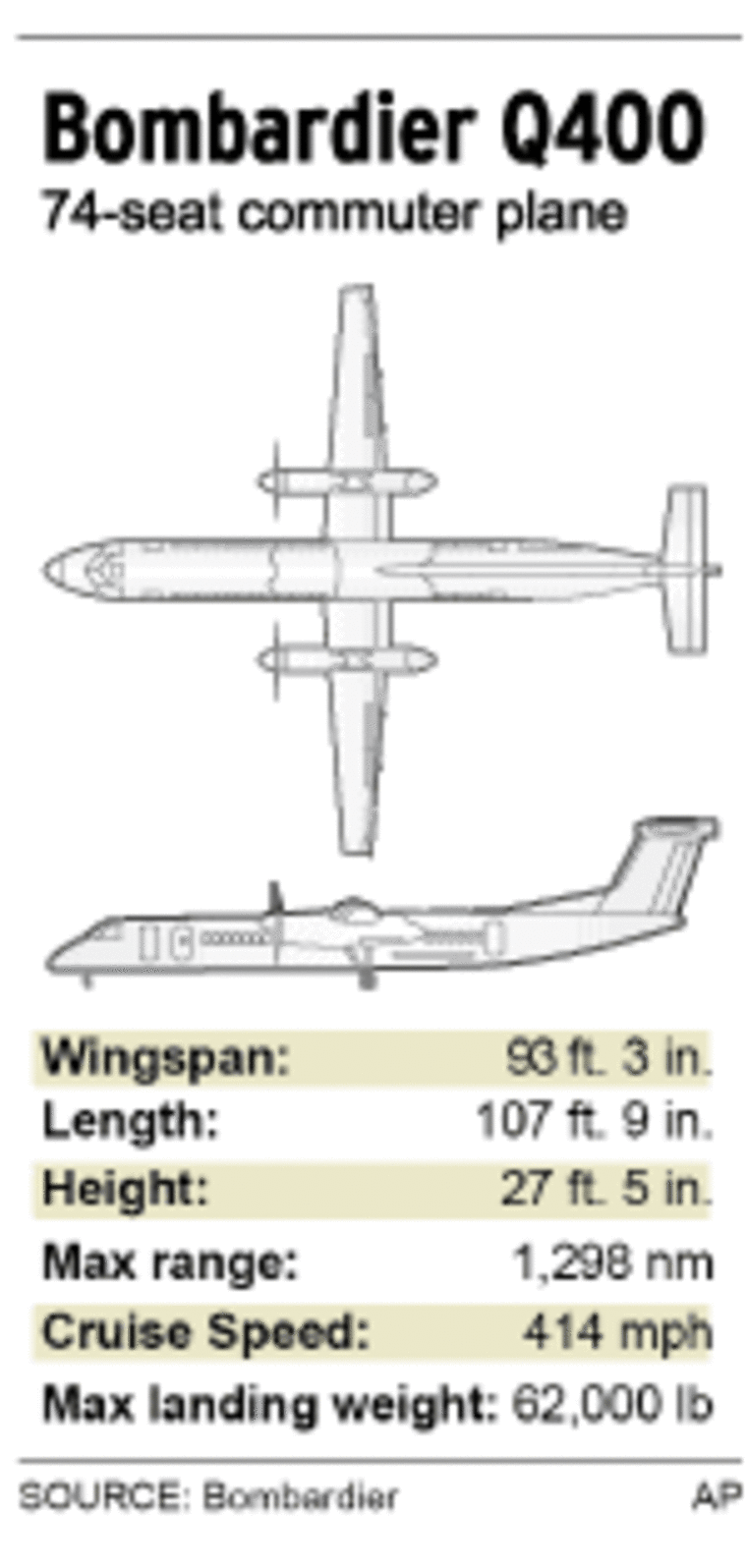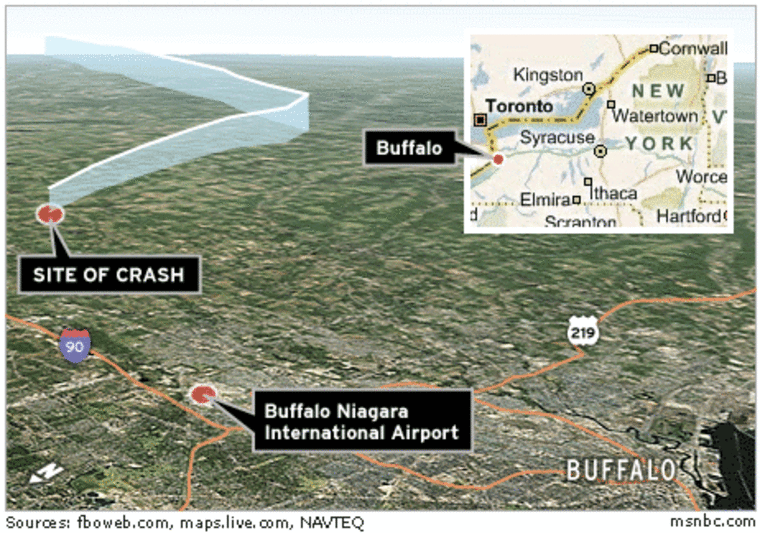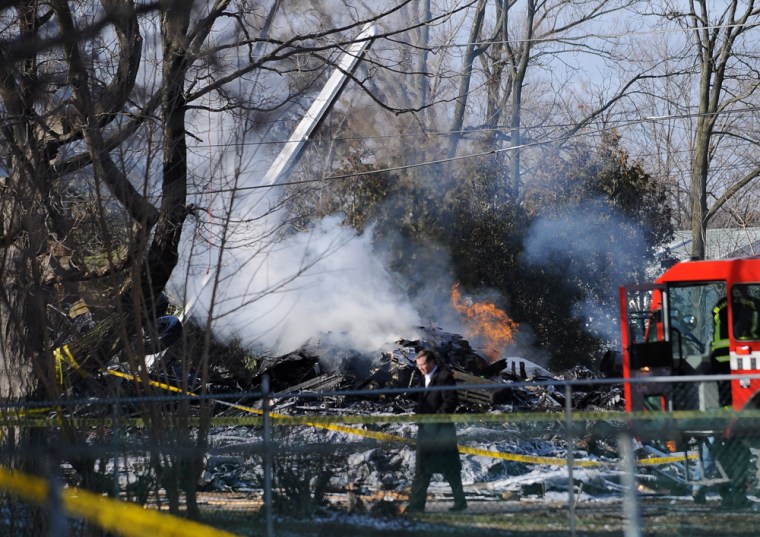The crew of a commuter plane that fell out of the sky, killing all 49 people aboard and one person on the ground, noticed significant ice buildup on the wings and windshield just before the plane began pitching and rolling violently, investigators said Friday.
Officials stopped short of saying the ice buildup caused Thursday night's crash and stressed that nothing had been ruled out. But ice on a plane's wings can interfere catastrophically with an aircraft's handling and has been blamed for a number of major air disasters over the years.
Continental Connection Flight 3407, bound from Newark, N.J., went down in light snow and mist — ideal conditions for ice to form — about six miles short of the Buffalo airport, plunging nose-first through the roof of a house in the suburb of Clarence.
All 44 passengers, four crew members, an off-duty pilot and one person on the ground were killed. Two others escaped from the home, which was engulfed in a raging fireball that climbed higher than the treetops and burned for hours. Authorities began removing the bodies around nightfall Friday.
Two others escaped from the home, which was engulfed in a dramatic fireball that raged higher than the treetops and burned for hours, making it too hot to begin removing the bodies until around nightfall Friday.
At a news conference, federal investigators summarized information retrieved from the "black boxes" — the flight data and cockpit voice recorders — recovered from the crash site.
The crew of the twin turboprop reported snow and mist and poor visibility at 16,000 feet and asked permission from air-traffic controllers to descend.
The crew noted “significant ice buildup, ice on windshield and wings,” Chealander said.
The flight data recorder indicated the plane's de-icing equipment was in the "on" position, but Chealander would not say whether the equipment was functioning.
The landing gear was lowered one minute before the end of the flight at an altitude of more than 2,000 feet, and 20 seconds later the wing flaps were set to slow the plane down, after which the aircraft went through "severe pitch and roll," Chealander said.
The crew raised the landing gear at the last moment, just before the recording ran out.

Doug Hartmayer, a spokesman for Niagara Frontier Transportation Authority, which runs the Buffalo Niagara International Airport, said: "The plane simply dropped off the radar screen."
"Icing, if a significant buildup, is an aerodynamic impediment, if you will," Chealander said. "Airplanes are built with wings that are shaped a certain way. If you have too much ice, the shape of the wing can change requiring different airspeeds."
But he refused to draw any conclusions from the data, and cautioned: "We are not ruling anything in or anything out at this time."
No mayday
call
William Voss, a former official of the Federal Aviation Administration and current president of the Flight Safety Foundation, a nonprofit advocacy group, said the plane's near vertical drop suggests that ice or a mechanical failure, such as wing flaps deploying asymmetrically or the two engines putting out different thrust, caused the crash.
After the crash, at least two pilots were heard on air traffic control circuits saying they had been picking up ice on their wings.
No mayday call came from the pilot before the crash, according to a recording of air traffic control's radio messages captured by the Web site LiveATC.net.
Federal investigators recovered the black box recorders from the smoldering wreckage Friday and returned them to Washington. The 74-seat Q400 Bombardier aircraft, in the Dash 8 family of planes, was operated by Colgan Air, based in Manassas, Va. Colgan's parent company, Pinnacle Airlines of Memphis, said the plane was new and had a clean safety record.
The pilot, Capt. Marvin Renslow, had been with the airline for nearly 3 1/2 years and had more than 3,000 hours of flying experience with the carrier. The associate pastor at Renslow's church north of Tampa said in a statement on behalf of Renslow's family that the pilot died doing what he loved.
"They're very proud of Marvin's accomplishments as a pilot. They know that he did everything that he could to save as many lives as he could, even in the accident. Marvin loved to fly," said Alan Burner of the First Baptist Church of Lutz.
Survivor's tale The plane was carrying a four-member crew and an off-duty pilot. Among the 44 passengers killed were of Sept. 11, 2001, and .
One person was killed in the house that was struck; two others, Karen Wielinski, 57, and her 22-year-old daughter, Jill, escaped with minor injuries. They were treated at a hospital and released.

Karen Wielinski told WBEN-AM in Buffalo that she was watching TV in the family room in the back of the house when she heard a noise. Her daughter was in an upstairs bedroom.
"Planes do go over our house, but this one just sounded really different, louder, and I thought to myself, 'If that's a plane, it's going to hit something,'" she told the station. "The next thing I knew the ceiling was on me."
Wielinski said she and her daughter managed to crawl out of a hole in the wreckage as fire erupted.
She said her 61-year-old husband, Doug, was in the dining room in the center of the house — and that's where the plane hit. "He was a good person, loved his family."
Officials have confirmed that one person in the home was killed, but they did not immediately release the victim's name.
Icing a known problem Flight 3407 is the first fatal crash of a commercial airliner in the United States since Aug. 27, 2006, when 49 people were killed after a Comair jetliner mistakenly took off from a Lexington, Ky., runway that was too short.
The crash came less than a month after a US Airways pilot guided his crippled plane to a landing in the Hudson River in New York City, saving the lives of all 155 people aboard. Birds had apparently disabled both its engines.
In general, smaller planes like the Dash 8, which uses a system of pneumatic de-icing boots, are more susceptible to icing problems than larger commuter planes that use a system to warm the wings. The boots, a rubber membrane stretched over the surface, are filled with compressed air to crack any ice that builds up.
A similar turboprop jet crash 15 years ago in Indiana was caused by icing, and after that the NTSB issued icing recommendations to more aggressively use the plane's system of pneumatic de-icing boots. But the FAA hasn't adopted it. It remains part of the NTSB's most-wanted safety improvements list.
No prior problems with plane
"It didn't sound normal," said David Luce, who was at home with his wife when they heard the plane come in low. he said. "We heard it for a few seconds, then it stopped, then a couple of seconds later was this tremendous explosion."
The 74-seat Q400 Bombardier aircraft, registered last April, was delayed almost two hours before departing Newark, N.J.
But Philip H. Trenary, who heads Pinnacle Airlines Corp. and operator Colgan Air, said at a news conference Friday that he didn't know why there was a delay.
Trenary said the plane was a "next-generation turbo prop, very modern."
"It's an aircraft that's had flawless service," he said. "So no, there have been no indications of problems with the aircraft."
Bombardier spokesman Marc Duchesne said the plane was put into service very recently and is only a few months old.
Bombardier said it was the first fatal crash involving a Dash 8 Q400 aircraft.
